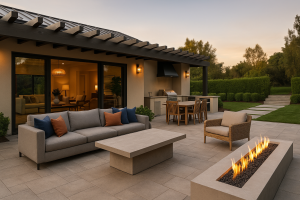When we talk about restaurant construction, we’re referring to the process of building or renovating a restaurant. It requires careful planning, design, and construction to create a space that is both functional and aesthetically pleasing.
Restaurant construction involves a variety of professionals and services, from architects and engineers to contractors and designers. Everyone works together to bring the vision of the restaurant owner or investor to life.
Whether you’re building a new restaurant from scratch or renovating an existing space, restaurant construction is an essential aspect of the process. In this comprehensive guide, we’ll explore everything you need to know about restaurant construction, from the process and timeline to important considerations, permits and regulations, design elements, materials, efficiency, sustainability, quality, and safety standards.
So, what is restaurant construction? Let’s dive in and find out.
The Process of Restaurant Construction
Restaurant construction involves a series of stages, each of which is critical to ensure the successful completion of a new restaurant. Understanding the process of restaurant construction is important to ensure that the project stays on track, the budget is followed, and deadlines are met.
Stage 1: Planning and Design
Before breaking ground on a new restaurant, thorough planning and design work is necessary. This stage involves creating a detailed plan of the restaurant’s layout, selecting materials, and choosing equipment. It is crucial to ensure the design is in accordance with the restaurant’s vision, and that it will be functional and efficient for both the staff and customers.
The planning and design stage also includes securing the necessary permits and licenses required for construction. This can involve working with both local and state regulatory agencies to ensure compliance with zoning laws, building codes, and safety regulations.
Stage 2: Construction
After the planning and design stage is complete, construction can begin. During this stage, the restaurant will be built according to the design plan. This can involve excavation, pouring concrete, framing, electrical installation, plumbing, and roofing.
It is important to have a skilled team of professionals to ensure the construction process is carried out smoothly. This can include a general contractor, electricians, plumbers, HVAC technicians, and carpenters.
Stage 3: Completion
The final stage of restaurant construction is completion. At this stage, the finishing touches are added to the restaurant, such as painting, installing flooring, and adding fixtures. The equipment is also installed, and the restaurant is ready to be furnished, decorated, and opened for business.
During the completion stage, it is important to conduct a final inspection of the restaurant to ensure it is safe and meets quality standards. The restaurant owner should also ensure that all necessary licenses and permits have been obtained.
Important Considerations in Restaurant Construction
Undertaking a restaurant construction project requires careful consideration of various factors to ensure a successful outcome. From planning and design to construction and completion, every stage demands attention to detail and adherence to quality and safety standards. Here are some key considerations to keep in mind:
Timeline
The timeline for a restaurant construction project depends on various factors, including the size of the restaurant, complexity of design, and availability of labor and materials. It is crucial to set realistic timelines and establish clear deadlines for each stage of the project to avoid delays and ensure timely completion.
Cost
The cost of restaurant construction can vary greatly depending on the size and scope of the project, materials used, labor costs, and other factors. It is essential to create a detailed budget and develop a cost management plan to stay within the allocated budget and avoid unexpected expenses.
Choosing the Right Construction Company
Choosing the right construction company is a critical factor that can significantly impact the outcome of a restaurant construction project. It is crucial to select a reputable, experienced and skilled construction company with a proven track record of delivering high-quality projects on time and within budget. Research and compare different companies, check their credentials, reviews, and past projects before making a decision.
Utilizing Construction Services and Contractors
Restaurant construction often involves complex and specialized tasks that require the expertise of skilled professionals. It is essential to engage the services of reputable and experienced contractors for specific tasks, such as plumbing, electrical installations, HVAC systems, and other specialized areas. Utilizing construction services can also help save time, reduce costs, and improve the overall quality of the project.
Understanding Restaurant Construction Permits and Regulations
Restaurant construction involves obtaining necessary permits and adhering to various regulations before and during the construction process. This section will cover the different permits and regulations that must be considered.
Restaurant Construction Permits
Before beginning construction, a restaurant owner must obtain a building permit from the appropriate city or county department. This permit ensures that the proposed restaurant construction project meets all applicable building codes and regulations.
Additionally, depending on the location and scope of the project, other permits may be required, such as zoning permits, environmental permits, and health department permits. Failure to obtain these permits can result in delays, legal issues, and fines.
Restaurant Construction Regulations
Restaurant owners must also adhere to various regulations during the construction process to ensure the safety and legality of the project. These regulations include building codes, zoning laws, and health and safety regulations.
Building codes specify the minimum standards for building design, construction, and safety. Zoning laws dictate how the building and its use must comply with local zoning ordinances. Health and safety regulations cover food preparation and storage, sanitation, ventilation, and fire safety.
Restaurant owners should work closely with their construction company to ensure that all necessary permits are obtained and regulations are followed.
Designing a Restaurant: Key Elements and Considerations
Designing a restaurant is a critical aspect of restaurant construction. A well-planned and well-executed design can attract customers, optimize the use of space, and enhance the overall dining experience. Here are some key elements and considerations to keep in mind when designing a restaurant:
Layout
The layout of a restaurant should be a balance between aesthetic appeal and functionality. It should optimize the use of space while providing comfortable seating arrangements, appropriate spacing, and easy accessibility to different areas of the restaurant. Factors such as the number of tables, the size of the kitchen, and the location of restrooms should also be taken into account.
Seating Arrangements
Choosing the right seating arrangement for a restaurant can greatly impact the dining experience. Different seating arrangements, such as booths, tables, and bar seating, can create a different mood and ambiance. The seating capacity should be in line with the restaurant size and layout and should not compromise customer comfort and privacy.
Kitchen Design
The design of the kitchen should be functional, safe, and conducive to efficiency. The kitchen layout should optimize workflow, provide adequate space for different stations, and enable smooth transition between different tasks. The design should also prioritize safety by incorporating proper ventilation, fire protection, and equipment placement.
Aesthetic Considerations
The aesthetic design of a restaurant can play a crucial role in creating a memorable dining experience. The design should reflect the restaurant’s brand, theme, and personality, while also appealing to the target audience. Elements such as lighting, color scheme, artwork, and décor should be carefully chosen to create a harmonious and inviting ambiance.
Selecting Materials for Restaurant Construction
Choosing the right materials for your restaurant construction project is crucial for ensuring durability, functionality, and aesthetic appeal. From flooring to countertops, selecting the right materials requires careful consideration of various factors. Here are some of the commonly used materials in restaurant construction and what you should know about them:
Flooring
The flooring of your restaurant should be durable, slip-resistant, and easy to clean. Some popular choices include vinyl, tile, concrete, and hardwood. While hardwood can add warmth and elegance to your restaurant, it may not be the most practical choice for high-traffic areas. On the other hand, vinyl is affordable, easy to maintain, and slip-resistant, making it a popular choice among restaurant owners.
Walls
When it comes to walls, consider the ease of cleaning, durability, and the overall aesthetic of your restaurant. Some materials to consider include painted drywall, ceramic tile, and brick. Painted drywall is a cost-effective option that can be easily replaced or updated, while ceramic tile and brick offer durability and a classic look.
Countertops
The countertops in your restaurant should be durable, easy to clean, and visually appealing. Some popular materials include granite, quartz, solid surface, and stainless steel. Granite and quartz are known for their durability and natural beauty, while solid surface and stainless steel offer easy cleaning and customization options.
Lighting Fixtures
The lighting fixtures you choose can greatly impact the ambiance of your restaurant. Consider factors such as energy efficiency, functionality, and style when selecting lighting fixtures. LED lighting is a popular choice for its energy efficiency and longevity, while pendant lights and chandeliers can add a touch of elegance to your restaurant’s design.
Ensuring Efficiency and Sustainability in Restaurant Construction
Efficiency and sustainability are crucial considerations in restaurant construction, not only for environmental reasons but also for cost-effectiveness and long-term success. Here are some important steps to take to ensure efficiency and sustainability in your restaurant construction project:
1. Utilize Eco-friendly Materials
Choose building materials that are environmentally friendly and sustainable, such as recycled materials, natural fibers, and low-VOC (volatile organic compounds) paints. These materials not only reduce your carbon footprint, but they can also improve indoor air quality for customers and staff.
2. Optimize Energy Usage
Implement energy-efficient practices in all aspects of your restaurant, including lighting, heating, cooling, and ventilation. Use LED lighting, programmable thermostats, and Energy Star rated appliances to reduce energy consumption and lower your utility bills.
3. Implement Waste Management Systems
Develop a comprehensive waste management system for your restaurant, including recycling, composting, and proper disposal of hazardous materials. This not only reduces your environmental impact, but it can also save you money on waste disposal fees.
A successful restaurant construction project involves balancing efficient design, sustainable practices, and cost-effective materials. By incorporating these principles, you can create a thriving restaurant that benefits both the environment and your business.
Maintaining Quality and Safety Standards in Restaurant Construction
Restaurant construction requires attention to detail and adherence to high-quality standards to ensure that the final product is both functional and aesthetically pleasing. It is also crucial to maintain safety standards throughout the construction process.
Skilled Labor
One of the most important factors in maintaining quality and safety in restaurant construction is selecting skilled and experienced labor. Working with trained professionals who have experience with restaurant construction can ensure that all aspects of the design and construction process are executed to the highest standards. This includes working with electricians, plumbers, carpenters, and builders who have experience in restaurant construction and understand the importance of quality work.
Safety Protocols
When it comes to safety, there are various protocols that need to be followed during restaurant construction. For example, an appropriate safety plan must be developed before work begins, which includes measures such as protective equipment, fire alarms, and emergency exits. Regular inspections during the construction process can also help to identify and address any safety concerns or hazards.
Inspections
Regular inspections throughout the construction process are essential for ensuring that quality and safety standards are being met. This includes inspections at every stage of the construction process, from foundation and framing to electrical and plumbing work. These inspections can help to identify any issues or concerns before they become major problems, ensuring that the final product is safe, functional, and in compliance with all necessary regulations.
FAQ – Frequently Asked Questions about Restaurant Construction
Here are some answers to the most common questions about restaurant construction:
What is restaurant construction?
Restaurant construction refers to the process of building or renovating a space to create a functional and inviting environment for a food service establishment.
What are the important considerations in restaurant construction?
There are several important factors to consider when undertaking restaurant construction, including the timeline, cost, choosing the right construction company, and utilizing construction services and contractors.
What permits and regulations are necessary for restaurant construction?
Permits and regulations necessary for restaurant construction include zoning requirements, building codes, and health and safety regulations. It is important to adhere to these regulations to ensure the safety of employees and customers and avoid fines or legal issues.
What elements should be considered when designing a restaurant?
When designing a restaurant, important elements to consider include layout, seating arrangements, kitchen design, and aesthetic considerations. These factors can impact the overall customer experience and the efficiency of operations.
What materials are commonly used in restaurant construction?
Commonly used materials in restaurant construction include flooring, walls, countertops, and fixtures. It is important to choose materials that are durable, functional, and aesthetically pleasing to create a welcoming and efficient environment.
How can efficiency and sustainability be incorporated into restaurant construction?
Efficiency and sustainability can be incorporated into restaurant construction by utilizing eco-friendly materials, optimizing energy usage, and implementing waste management systems. These practices can reduce operating costs and minimize the impact on the environment.
Why is maintaining quality and safety standards important in restaurant construction?
Maintaining high quality and safety standards throughout the restaurant construction process is crucial to ensure the safety of employees and customers. This involves using skilled labor, following safety protocols, and conducting regular inspections to identify and address any potential hazards.










